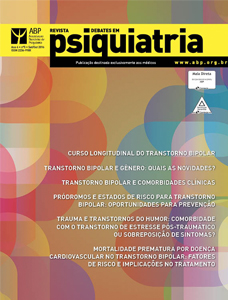Trauma and mood disorders: comorbidity with post-traumatic stress disorder or overlapping symptoms?
DOI:
https://doi.org/10.25118/2236-918X-6-5-5Keywords:
Trauma, mood disorders, post-traumatic stress disorder, dysphoric symptoms, Research Domain CriteriaAbstract
This paper presents a discussion about comorbidity between bipolar disorder (BD) and post-traumatic stress disorder (PTSD) and suggests the need for some cases to be better evaluated in light of the new theories proposed by the Research Domain Criteria (RDoC) – especially those cases in which PTSD co-occurs with dysphoric symptoms that may be classified as BD, even when not fulfilling all the criteria. In this case, comorbidity is questioned, and a deeper knowledge of the physiopathology of the overlapping symptomatologyis proposed. Clinically, this new view can facilitate the pharmacological management of severe patients with a history of trauma.
Downloads
Metrics
References
Hernandez JM, Cordova MJ, Ruzek J, Reiser R, Gwizdowski IS, Suppes T, et al. Presentati on and prevalence of PTSD in a bipolar disorder populati on: a STEP-BD examinati on. J Aff ect Disord. 2013;150:450-5.
Quaranti ni LC, Miranda-Scippa A, Nery-Fernandes F, Andrade-Nascimento M, Galvão-de-Almeida A, Guimarães JL, et al. The impact of comorbid postt raumati c stress disorder on bipolar disorder pati ents. J Aff ect Disord. 2010;123:71-6.
American Psychiatric Associati on. Diagnosti c and Stati sti cal Manual of Mental Disorders, Fift hEditi on (DSM-5). Arlington: American Psychiatric Publishing; 2013.
Armour C, Mullerova J, Elhai JD. A systemati c literature review of PTSD’s latent structure in the Diagnosti c and Stati sti cal Manual of Mental Disorders: DSM-IV to DSM-5. Clin Psychol Rev. 2016;44:60-74.
Associação Americana de Psiquiatria. Manual Diagnósti co e Estatí sti co de Transtornos Mentais, 4ª edição (DSM-IV). Porto Alegre: Artes Médicas; 1995.
Elhai JD, Palmieri PA. The factor structure of postt raumati c stress disorder: a literature update, criti que of methodology, and agenda for future research. J Anxiety Disord. 2011;25:849-54.
Hansen M, Armour C, Elklit A. Assessing a dysphoric arousal model of acute stress disorder symptoms in a clinical sample of rape and bank robbery victi ms. Eur J Psychotraumatol. 2012;3. doi: 10.3402/ejpt.v3i0.18201. Epub 2012 Jun 12.
Nardi AE, Kapczinski F, Quevedo J, Hallak JE, Freire R, Romano-Silva MA. The quest for bett er diagnosis: DSM-5 or RDoC? Rev Bras Psiquiatr. 2013;35:109-10.
Nati onal Insti tute of Mental Health (NIMH). Research Domain Criteria (RDoC) [Internet]. 2016 [cited 2016 Oct 18]. https://www.nimh.nih.gov/research-priorities/rdoc/index.shtml
Iwata M, Ota KT, Duman RS. The infl ammasome: pathways linking psychological stress, depression, and systemic illnesses. Brain Behav Immun. 2013;31:105-14.
Passos IC, Vasconcelos-Moreno MP, Costa LG, Kunz M, Brietzke E, Quevedo J, et al. Infl ammatory markers in post-traumati c stress disorder: a systemati c review, meta-analysis, and metaregression. Lancet Psychiatry. 2015;2:1002-12.
Berk M, Williams LJ, Jacka FN, O’Neil A, Pasco JA, Moylan S, et al. So depression is an infl ammatory disease, but where does the infl ammati on come from? BMC Med. 2013;11:200.
Buchmann AF, Holz N, Boecker R, Blomeyer D, Rietschel M, Witt SH, et al. Moderati ng role of FKBP5 genotype in the impact of childhood adversity on corti sol stress response during adulthood. Eur Neuropsychopharmacol, 2014;24:837-45.
Soeiro-de-Souza MG, Dias VV, Figueira ML, Forlenza OV, Gatt az WF, Zarate CA Jr, et al. Translati ng neurotrophic and cellular plasti city: from pathophysiology to improved therapeuti cs for bipolar disorder. Acta Psychiatr Scand. 2012;126:332-41.
Rakofsky JJ, Ressler KJ, Dunlop BW. BDNF functi on as a potenti al mediator of bipolar disorder and post-traumati c stress disorder comorbidity. Mol Psychiatry. 2012;17:22-35.
Milad MR, Rosenbaum BL, Simon NM. Neuroscience of fear exti ncti on: implicati ons for assessment and treatment of fear-based and anxiety related disorders. Behav Res Ther. 2014;62:17-23.
Mello MF, Faria AA, Mello AF, Carpenter LL, Tyrka AR, Price LH. [Childhood maltreatment and adult psychopathology: pathways to hypothalamicpituitary-adrenal axis dysfuncti on]. Rev Bras Psiquiatr. 2009;31:S41-8.
Nusslock R, Miller GE. Early-life adversity and physical and emoti onal health across the lifespan: a neuroimmune network hypothesis. Biol Psychiatry. 2016;80:23-32.
Downloads
Published
How to Cite
Conference Proceedings Volume
Section
License

This work is licensed under a Creative Commons Attribution-NonCommercial 4.0 International License.
Debates em Psiquiatria allows the author (s) to keep their copyrights unrestricted. Allows the author (s) to retain their publication rights without restriction. Authors should ensure that the article is an original work without fabrication, fraud or plagiarism; does not infringe any copyright or right of ownership of any third party. Authors should also ensure that each one complies with the authorship requirements as recommended by the ICMJE and understand that if the article or part of it is flawed or fraudulent, each author shares responsibility.
Attribution-NonCommercial 4.0 International (CC BY-NC 4.0) - Debates em Psiquiatria is governed by the licencse CC-By-NC
You are free to:
- Share — copy and redistribute the material in any medium or format
- Adapt — remix, transform, and build upon the material
The licensor cannot revoke these freedoms as long as you follow the license terms. Under the following terms:
- Attribution — You must give appropriate credit, provide a link to the license, and indicate if changes were made. You may do so in any reasonable manner, but not in any way that suggests the licensor endorses you or your use.
- NonCommercial — You may not use the material for commercial purposes.
No additional restrictions — You may not apply legal terms or technological measures that legally restrict others from doing anything the license permits.






























